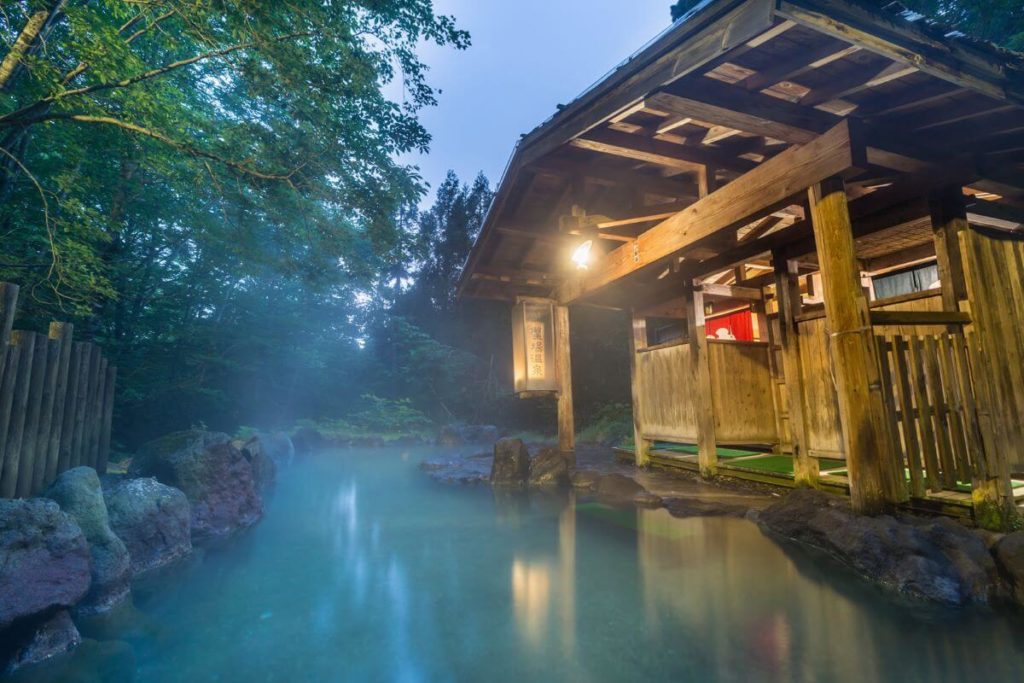Photo courtesy of Nyuto Onsenkyo Ganiba Onsen
You can’t have a trip to Japan complete without visiting an onsen.
If you’ve made it all the way to Japan, you mostly likely want to experience the customs and tradition before leaving, and onsen are a perfect way to do so.
Have you ever heard of an onsen town?
An onsen town is an area with many hotels and traditional Japanese inns (ryokan) all surrounding a hot spring.
For example, we will later go into detail about Kusatsu Onsen, which includes around 170 hotels and ryokans that all supply the natural water from the hot spring that flows through the ground of the town to their guests.
There are around 3,000 onsen towns all over Japan, and the onsen facilities total over 20,000.
- “Where should I go?”
- “I don’t want to choose the wrong place and regret it later!”
…is probably what you’re thinking, right?
Don’t worry. We’ve investigated the 3,000 onsen towns so you don’t have to!
In this article, we will be introducing 12 of the best onsen towns that we can recommend to those traveling in Japan.
We’ve also included information on some of the best ryokan in each area, so make sure to take a look.
In Japan, you’ll want to be connected without missing out on high speed data and internet!
By reserving online before departing, you can
- Lower your rental fees
- Avoid stock shortages at the airport
To learn more about data and WiFi options for your trip, check out our products below.

Hello readers! Sakura Mobile is a SIM & WiFi service provider for international residents and tourists in Japan.
Our global editorial team living in Japan will introduce the charms of the country based on what we have actually experienced and felt.
The 12 Top Onsen Towns:
- Kusatsu Onsen (Gunma Prefecture)
- Atami Onsen (Shizuoka Prefecture)
- Kinugawa Onsen (Tochigi Prefecture)
- Ikaho Onsen (Gunma Prefecture)
- Hakone Onsen (Kanagawa Prefecture)
- Noboribetsu Onsen (Hokkaido)
- Dogo Onsen (Ehime Prefecture)
- Beppu Onsen (Oita Prefecture)
- Kurokawa Onsen (Kumamoto Prefecture)
- Arima Onsen (Hyogo Prefecture)
- Yufuin Onsen (Oita Prefecture)
- Nyuto Onsen (Akita Prefecture)
1. Kusatsu Onsen (Gunma Prefecture)
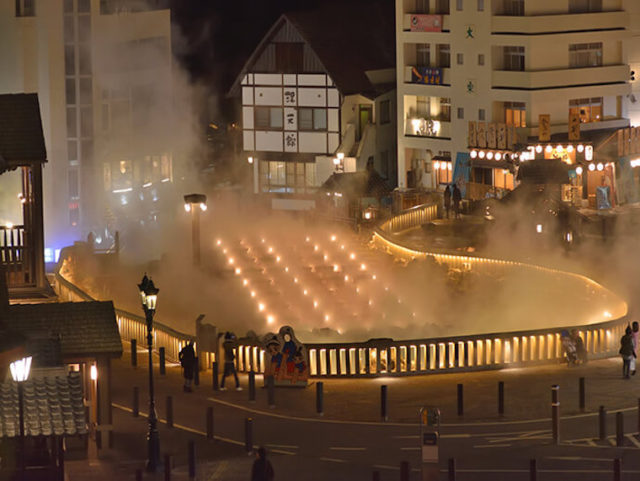
Kusatsu Onsen is an onsen town in Gunma Prefecture. It is located about 1,100 ~ 1,200 meters above sea level, surrounded by mountains.
Kusatsu Onsen is one of the three most famous onsen in Japan, and it would not be an exaggeration to say that it is surrounded by the most nature.
The most well-known aspect of Kusatsu is the area called the “Yubatake” (literally translated as “hot-spring field”). Just watching the stream of steaming blue-green water flow into the Yubatake can easily be the highlight of a trip.
There are many ryokan, hotels, souvenir shops, and restaurants lining the streets of Kusatsu. It may also be fun to try the various public baths in town.
Kusatsu Onsen is known for the quality of its water. The hot spring is quite acidic and is said to make your skin feel very smooth.
![]() Click below to play YouTube video↓↓
Click below to play YouTube video↓↓

Places to Stay
- 湯宿 季の庭 (Yuyado Toki no Niwa)
- 草津温泉 ホテルヴィレッジ (Kusatsu Onsen Hotel Village)
- 草津スカイランドホテル 栖風亭 (Kusatsu Skyland Hotel Seifuutei)
How to Get to Kusatsu from Tokyo
From Tokyo, you will need to go by train and bus. It will take around 3 to 4 hours and cost you around 3,000 to 6,000 JPY.
↑ Go back to the table of contents
2. Atami Onsen (Shizuoka Prefecture)
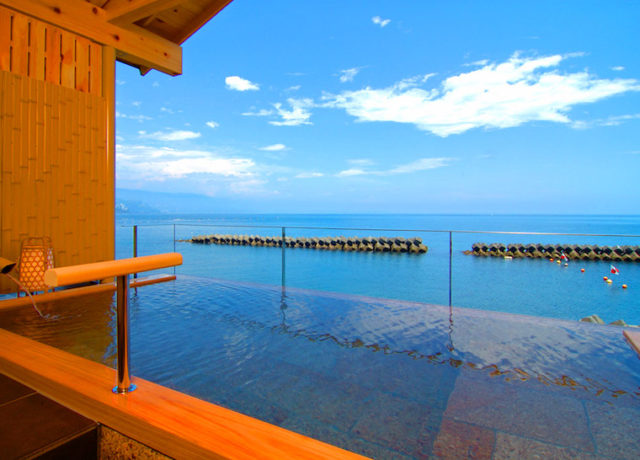
Atami Onsen is an onsen town in Shizuoka Prefecture. Known for the large quantity of hot spring water, Atami is one of the most notable hot springs of Japan.
The onsen town itself is over 1,000 years old; it is said to have been used by Japan’s feudal generals and lords.
A short ride on the bullet train from Tokyo Station, Atami is a popular spot for day trips.
Atami is well-known for putting on fireworks shows throughout the year. If you visit, you might even have a chance to watch fireworks from the bath in your room.
There are many shops in town so it is also recommended to take a walk and check them out. You can experience a fresh-fish barbecue which is popular among travelers and native Japanese people alike.
![]() Click below to play YouTube video↓↓
Click below to play YouTube video↓↓

Places to Stay
- 熱海後楽園ホテル (Atami Korakuen Hotel)
- リブマックスリゾート熱海シーフロント (Live Max Resort Atami Sea Front)
- 熱海 大観荘 (Atami Taikanso)
How to Get to Atami from Tokyo
From Tokyo station, there are multiple ways to get to Atami. Taking the bullet train takes anywhere from 35 to 50 minutes and will cost you a little less than 4,000 JPY one way. If you are looking to save money, you can also ride the local train for around an hour and 45 minutes for about half the price.
↑ Go back to the table of contents
3. Kinugawa Onsen (Tochigi Prefecture)
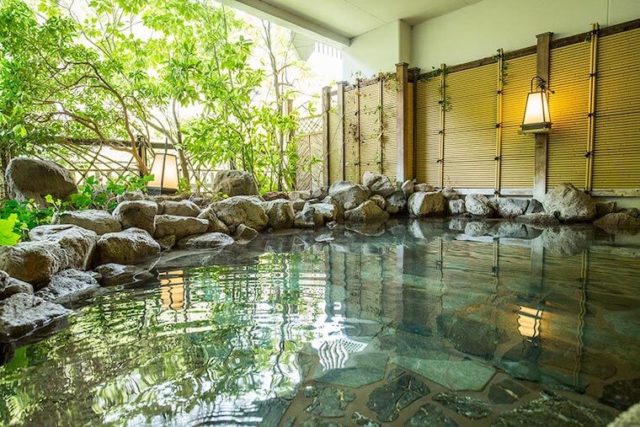
Kinugawa Onsen is a popular vacation spot, with over 2 million visitors yearly. It has a reputation for being inexpensive compared to other more popular onsen towns and is just a few hours from Tokyo.
The water of the hot spring is said to be effective for joint and muscle pain, as well as having health benefits.
One of the best aspects of Kinugawa, however, may be its accessibility to a variety of attractions.
Kinugawa is close to Nikko, which is a tourist spot famous for its shrines and landscapes. As well as being surrounded by nature, there are amusement parks and a ski resort close-by that you can visit if you are planning on spending multiple nights in Kinugawa.
![]() Click below to play YouTube video↓↓
Click below to play YouTube video↓↓

Places to Stay
- 鬼怒川温泉 あさや (Kinugawa Onsen Asaya)
- ホテルサンシャイン鬼怒川 (Hotel Sunshine Kinugawa)
- 鬼怒川温泉 山楽 (Kinugawa Onsen Sanraku)
How to Get to Kinugawa from Tokyo
From Ueno Station (which is about a 10 minute train ride from Tokyo Station) Kinugawa is a 2 hour train ride that will cost bout 3,000 JPY.
↑ Go back to the table of contents
4. Ikaho Onsen (Gunma Prefecture)
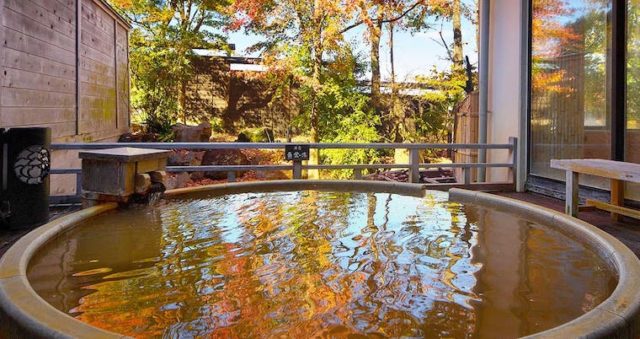
Like Kusatsu, Ikaho Onsen is another representative onsen of Gunma Prefecture. It has a deep history and is said to have been discovered anywhere between 1,300 and 1,900 years ago.
It has also been said that many famous Japanese authors such as Natsume Souseki visited Ikaho Onsen.
There are two notable types of water in Ikaho. One is called “golden water,” which is actually a golden color thanks to the iron in the water. This type has been highly praised in the reviews of people who have visited Ikaho Onsen.
The other is called, “silver water” which contains a chemical compound called Metasilicic acid. These types of water are characterized by the lightness on the skin and health benefits.
A type of udon called Mizusawa Udon is a well-known food in this area; if you are visiting Ikaho, you should be sure to give it a try.
![]() Click below to play YouTube video↓↓
Click below to play YouTube video↓↓

Places to Stay
- 伊香保温泉 ホテル木暮 (Ikaho Onsen Hotel Kogure)
- 伊香保温泉 如心の里 ひびき野 (Ikaho Onsen Joshin No Sato Hibikino)
- 和心の宿 大森 (Nagomigokoro no Yado Omori)
How to Get to Ikaho from Tokyo
Taking the recommended and shortest route to Ikaho will take about an hour and 45 minutes and will cost you a little less than 5,000 JPY.
Depending on your how many times you are willing to transfer and how long you are willing to ride the train, however, your transportation costs to Ikaho may vary. Going by local train will save you around 2,500 JPY but will require you to make extra transfers as well as ride the train for an extra 40 minutes.
There is also a bus that departs from Shinjuku and goes directly to Ikaho Onsen in about two and a half hours. The price varies by the season but usually costs around 3,000 JPY.
↑ Go back to the table of contents
5. Hakone Onsen (Kanagawa Prefecture)
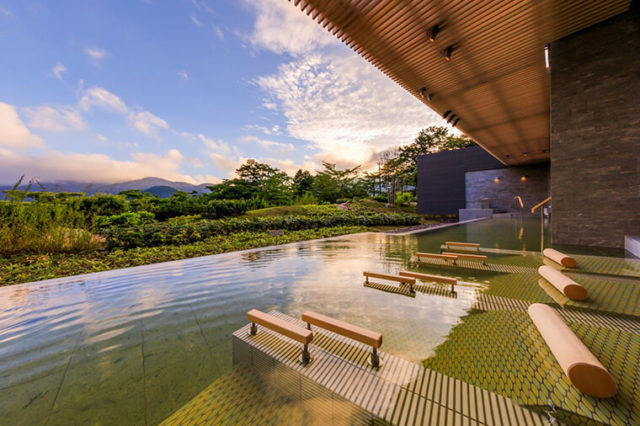
Hakone Onsen is actually a collection of onsen towns that run from the foot to around the halfway point of a volcano. Hakone was first opened in the year 738 and continues to be used today.
Surrounded by nature and adorned with stunning views of Mt. Fuji, Hakone Onsen is a very popular vacation spot for both Japanese people and travelers from overseas. Located in Kanagawa Prefecture, it is easily accessible from Tokyo.
Because Hakone Onsen is so well known, it is generally very crowded. However, this also makes it tourist-friendly; you can find many shops and restaurants in close proximity.
There are lots of activities to enjoy around Hakone. You can enjoy looking down at nature from the ropeway or take a ride on a pirate-themed cruise ship down the river.
It is highly recommended to get a Hakone Free Pass, which lets you ride the transportation in the Hakone area for free as well as get discounts on many tourist attractions. The free pass includes the train fare from multiple different train stations in and around Tokyo.
![]() Click below to play YouTube video↓↓
Click below to play YouTube video↓↓

Places to Stay
- 箱根湯本温泉 ホテルおかだ (Hakone-yu Moto Onsen Hotel Okada)
- 和心亭 豊月 (Washintei Hougetsu)
- 箱根湯本温泉 天成園 (Hakone-yu Moto Onsen Tensei-en)
How to Get to Hakone from Tokyo
As mentioned earlier, there is an option to buy the Hakone Free Pass (5,700 JPY for a 2-day adult pass departing from Shinjuku). If you want to go without the pass, taking the bullet train will cost you about 3,500 JPY and taking the local train will cost you 1,800 JPY (both one way).
↑ Go back to the table of contents
6. Noboribetsu Onsen (Hokkaido)
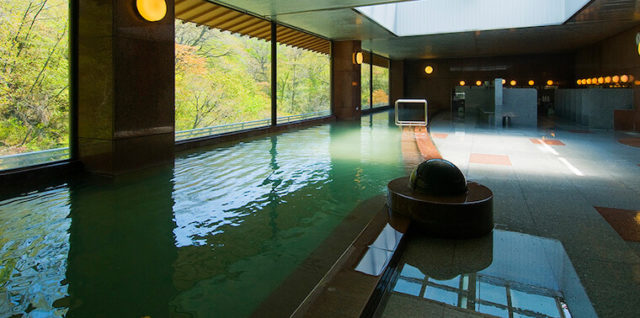
Located in the northernmost part of Japan, Hokkaido, Noboribetsu Onsen is famous for producing 9 types of water from its hot spring. Noboribetsu Onsen is consistently in the top rankings for best onsen.
The hot spring was created by a large volcanic eruption, and there remains a large explosion crater even today. The crater, called “Jigoku-dani” is now a popular tourist attraction for those visiting Noboribetsu.
Traveling from Tokyo will take you a while, as you will most likely be flying to Hokkaido first. Hokkaido is known for the cold and the snow, so you might want to take the opportunity to take a bath in the piping hot spring water while gazing out at a completely white landscape.
Out of the hotels in Noboribetsu there are many that offer day-trip options, which makes it easy to try out all the different onsen. You can also witness geysers in town and enjoy shopping for souvenirs.
![]() Click below to play YouTube video↓↓
Click below to play YouTube video↓↓

Places to Stay
- 祝いの宿 登別グランホテル (Iwai no Yado Noboribetsu Grand Hotel)
- ホテルまほろば (Hotel Mahoroba)
- 登別温泉郷滝乃家 (Noboribetsu Onsenkyo Takinoya)
How to Get to Noboribetsu from Tokyo
Unless you have a Japan Rail pass, the cheapest way to get to Hokkaido is by airplane. The plane ride will take about an hour and a half, and after that, Noboribetsu is about an hour bus ride from Shin-Chitose Airport. It will cost you around 6,500 to 10,000 JPY depending on the season.
In Japan, you’ll want to be connected without missing out on high speed data and internet!
By reserving online before departing, you can
- Lower your rental fees
- Avoid stock shortages at the airport
To learn more about data and WiFi options for your trip, check out our products below.
↑ Go back to the table of contents
7. Dogo Onsen (Ehime Prefecture)
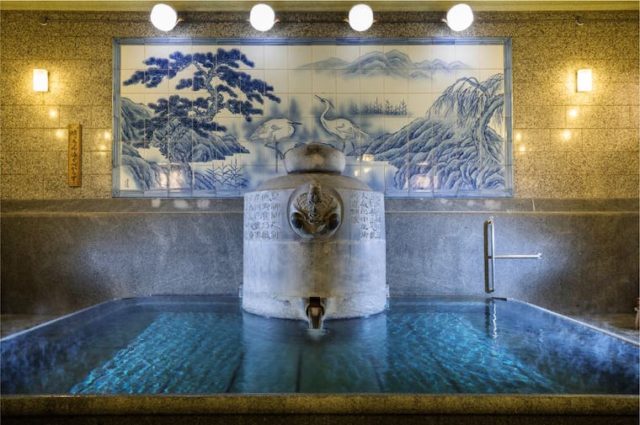
Dogo Onsen is recommended for anyone who is looking to observe the traditional atmosphere of Japan. It is one of three onsen in Japan that are especially well-known to have a lot of history. Dogo Onsen in particular is said to have over 3,000 years of history, and it has made appearances in many famous pieces of Japan’s literature.
Regardless of where you stay in Dogo, you should be sure to visit the main building of Dogo Onsen. The interior and the spa area scream “traditional” and you immediately feel as if you have been transported back to the olden days of Japan.
Aside from having a rich history, Dogo has lively shopping districts and street vendors. You can enjoy walking along the streets while eating street food.
It has also been said that Dogo Onsen was one of the models for the famous animated movie, “Spirited Away.” Whether you are a history lover or a Ghibli fan, you should consider giving Dogen Onsen a visit.
![]() Click below to play YouTube video↓↓
Click below to play YouTube video↓↓

Places to Stay
How to Get to Dogo from Tokyo
From Tokyo, it is easiest to take an airplane to Matsuyama Airport (in Ehime Prefecture) and then take a bus from there to get to Dogo Onsen. The whole journey will likely take you about two and a half to three hours and will cost you anywhere from 5,000 to 13,000 JPY depending on the season.
↑ Go back to the table of contents
8. Beppu Onsen (Oita Prefecture)
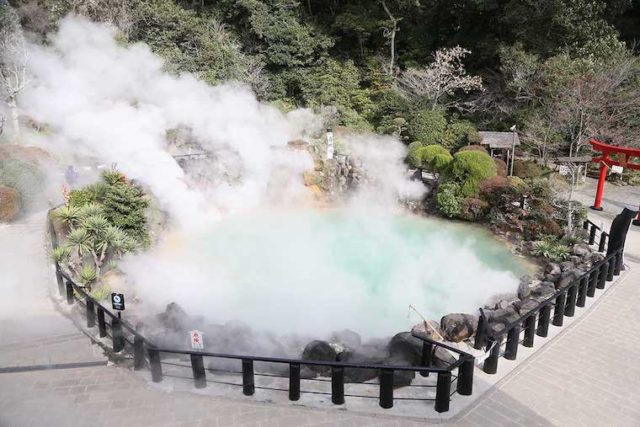
Beppu Onsen is actually a collection of 8 separate hot springs in Oita prefecture, located in the easternmost area of Japan. Oita is also known as the onsen prefecture, and Beppu Onsen produces the highest yield of hot spring water in all of Japan.
One of the most unique points of Beppu Onsen is a place called “Beppu Jigoku,” meaning “The Hells of Beppu.” It is a collection of hot springs, many of which are unusually colored due to the minerals inside the water. You can take tours of the various “hells,” buy souvenirs, or try foods that have been steamed in the water of the hot springs.
There are said to be 11 types of hot spring water in the 8 hot springs of Beppu, each with different health benefits. You might consider making your trip longer than just a day or two if you do not live in the area so you can try out lots of places.
There is also a large population of exchange students in Beppu, which makes entertainment and lots of places to eat and drink very accessible in the city.
![]() Click below to play YouTube video↓↓
Click below to play YouTube video↓↓

Places to Stay
- REX HOTEL 別府 (REX HOTEL Beppu)
- 別府温泉 杉乃井ホテル (Beppu Onsen Suginoi Hotel)
- 眺望の宿 しおり (Choubou no Yado Shiori)
How to Get to Beppu from Tokyo
You can get to Beppu by riding the expressway bus, by airplane, or by bullet train. The most inexpensive way to get to Beppu, however, is by airplane to Oita Airport and then a bus to Beppu. Depending on the season, the price can range from around 6,000 to 13,000 JPY.
↑ Go back to the table of contents
9. Kurokawa Onsen (Kumamoto Prefecture)
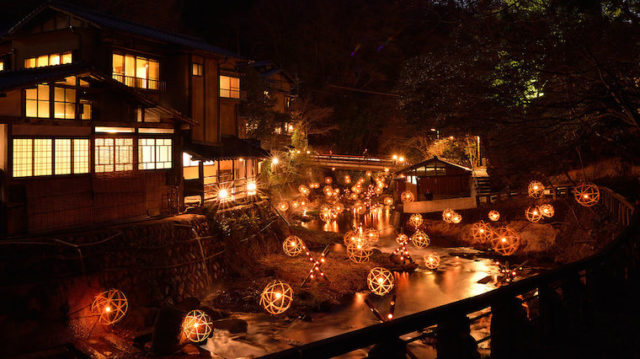
Kurokawa Onsen is located quite a ways away from the inner city area of Kumamoto Prefecture, pretty far into the mountains. It is a great spot for those who are looking for a quiet forest getaway.
Visitors to Kurokawa Onsen are encouraged to think of the onsen town as one big hotel, meaning that you are free to explore the baths of other accommodations and walk around freely.
Kurosawa Onsen holds a yearly event called “Yu-akari,” in which many places around town are decorated with circular lanterns made of bamboo. It is well lit up at night and makes for beautiful scenery. The event is held in the winter until the late spring.
If you are going to Kurokawa Onsen, you might consider exploring the town, trying out some traditional Japanese food, or taking a nature walk. Kurokawa Onsen has all kinds of baths; you can even find places to wash your face around town.
![]() Click below to play YouTube video↓↓
Click below to play YouTube video↓↓

Places to Stay
How to Get to Kurokawa from Tokyo
If you are not planning on getting a rental car, making your way to Kurokawa Onsen may take a while. The easiest and least expensive option is to take a plane to either Fukuoka Airport or Kumamoto Airport, and take a 2 hour bus ride from there. It will cost around 5,000 to 16,000 JPY depending on the season.
↑ Go back to the table of contents
10. Arima Onsen (Hyogo Prefecture)
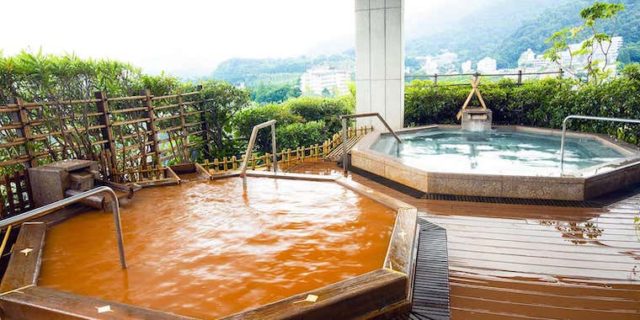
Like Dogo Onsen (mentioned earlier in this article), Arima Onsen is one of the three notable onsen in Japan with a rich history. It is located in Hyogo Prefecture, which is an easy trip for those who are living in places like Kyoto or Osaka.
A well-known type of hot spring water at Arima Onsen is the golden water, which differs from the golden water at Ikaho Onsen mentioned earlier. In Arima’s case, the water is loaded with an amount of salt that is even greater than the ocean.
The history of Arima Onsen goes all the way back to the Asuka Period of Japan (538 – 710). It is also said that Toyotomi Hideyoshi, a famous daimyo who was at one point regarded as one of the strongest men in Japan, visited Arima Onsen multiple times.
Aside from the actual hot springs, there are many other places to explore in Arima. You might consider visiting the area’s temples, shrines, and parks.
![]() Click below to play YouTube video↓↓
Click below to play YouTube video↓↓

Places to Stay
How to Get to Arima from Tokyo
There are many different ways to get to Arima Onsen. If you are trying to save money, taking a combination of the highway bus and the local train will only cost you around 4,000 JPY. However, the highway bus will take a total of 9 and a half hours.
For those who are willing to spend a bit more money and save time, taking a plane to Kobe Airport and taking the train from there will take about 2 and a half to 3 hours and cost around 11,000 to 14,000 JPY depending on the season.
↑ Go back to the table of contents
11. Yufuin Onsen (Oita Prefecture)
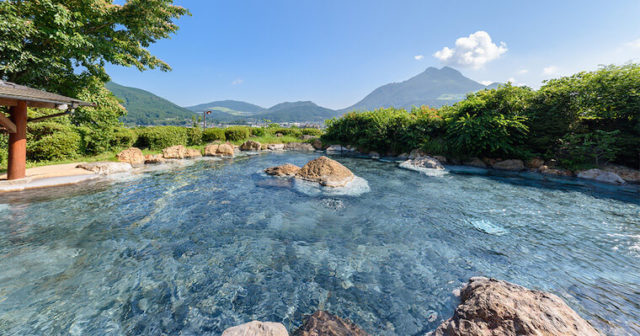
Located in the same prefecture as Beppu Onsen, Yufuin Onsen produces the second highest yield of hot spring water in Japan.
The highest pH of water that you can find in Yufuin is 9.7 and has moisturising properties for your skin.
Compared to places like the aforementioned Kurokawa Onsen, Yufuin has more of a western taste to the town, especially around the train station. You can also visit art museums, ride horse-drawn carriages, or try different types of foods and desserts.
In town, there are many types of fairs and events held year-round, making for an interesting tourist attraction. Yufuin is a great choice for those who want to explore the small-town areas of Japan.
![]() Click below to play YouTube video↓↓
Click below to play YouTube video↓↓

Places to Stay
How to Get to Yufuin from Tokyo
The fastest and most cost-effective way to get to Arima is by taking a plane to Oita Airport and then taking an hour long bus ride to Yufuin station. Depending on the season, it will cost you anywhere from 6,000 to 11,000 JPY.
↑ Go back to the table of contents
12. Nyuto Onsen (Akita Prefecture)
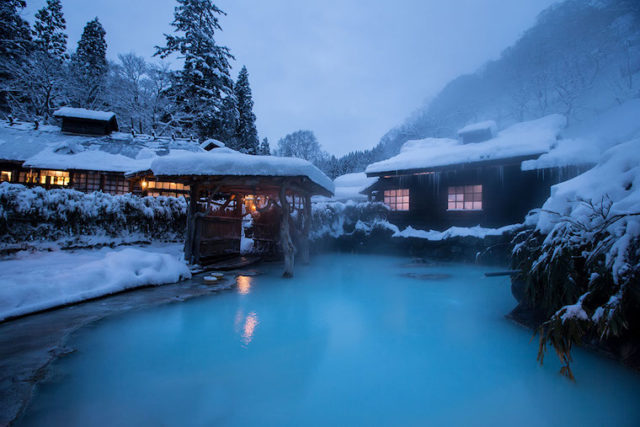
Akita Prefecture, which is in the northern part of Japan, is very cold during the winter but makes for the perfect hot spring trip. It is not often you get to bathe in a hot spring outside surrounded by snow.
Nyuto does not have as many places to shop or things to do compared to many of the other places on this list. However, the area does give off the feeling of an old Japanese village and will definitely give you a quiet place to relax if you are looking to take a short trip.
Compared to many more well-known onsen towns on this list, Nyuto Onsen only has 7 places to stay. But this makes it possible to visit all the hot springs, and there is a free shuttle bus that will take you around to all of them.
Nyuto Onsen is the perfect place for those who want to be surrounded by nature. It is recommended that you visit in the fall or the winter. In the fall, the autumn leaves make for scenic mountain adventure.
![]() Click below to play YouTube video↓↓
Click below to play YouTube video↓↓

Places to Stay
How to Get to Nyuto from Tokyo
The easiest (but most expensive) way to get to Nyuto is by taking the bullet train to Lake Tazawa station and then taking a bus from there. It will cost you around 17,000 JPY one way.
Another way to go is by taking a plane to Akita Airport and then taking a 2 hour long ride in a share taxi. This option will cost you a little over 10,000 JPY.
↑ Go back to the table of contents
Conclusion
Do you feel as if you are ready to go on a onsen vacation?
In this article we introduced a collection of onsen that we think are worth visiting, from very well known tourist locations to more hidden and rural spots. We hope that this helped you make a decision as to where to travel on your next vacation.
Onsen immerse you in everything that we consider to be Japan; we recommend that anyone visiting Japan just for a short time, or those who are just in need of a little break pay a visit.
Have you booked your SIM card or pocket WiFi for your trip to Japan yet?
In Japan, you’ll want to be connected without missing out on high speed data and internet!
By reserving online before departing, you can
- Lower your rental fees
- Avoid stock shortages at the airport
To learn more about data and WiFi options for your trip, check out our products below.
CUSTOMER’S VOICE

